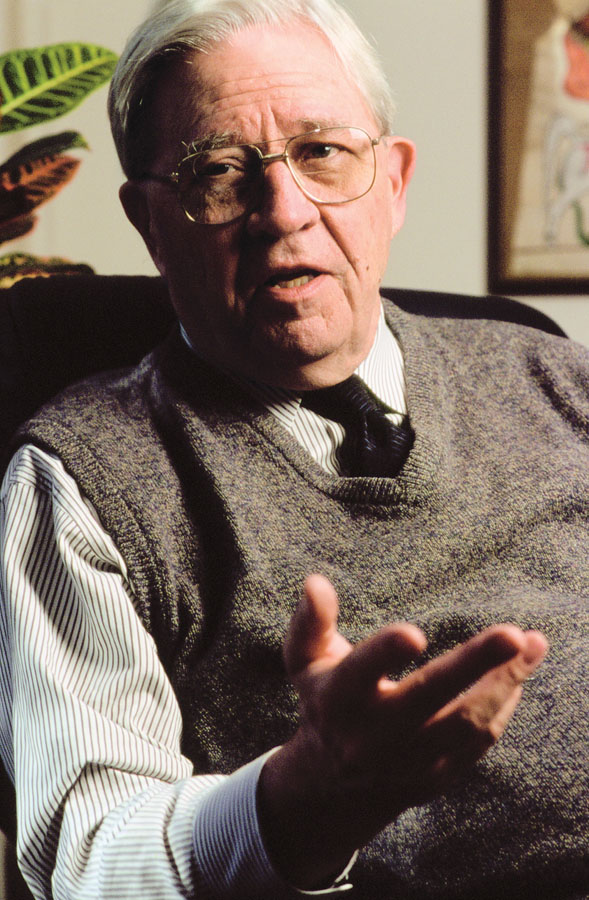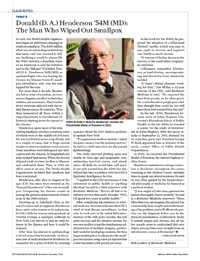Class Notes
 HERO IN PUBLIC HEALTH: Henderson received the Presidential Medal of Freedom in 2002. (Photo: Medical Center Public Relations)
HERO IN PUBLIC HEALTH: Henderson received the Presidential Medal of Freedom in 2002. (Photo: Medical Center Public Relations)In 1966, the World Health Organization began an ambitious campaign to eradicate smallpox. The $300 million effort was an astonishing undertaking that many said was doomed to failure. Realizing it would be a heavy lift, the WHO director, a Brazilian, wanted an American to lead the initiative and be the “fall guy” if it failed. Donald (D. A.) Henderson ’54M (MD), an epidemiologist who was leading the Centers for Disease Control’s smallpox surveillance unit, was the man tapped for the role.
For more than a decade, Henderson led an army of scientists, doctors, nurses, linguists, medical technicians, soldiers, and academics. They tracked down everyone infected with the lethal disease across 50 countries. They then immunized all those within a ring of proximity to the infected, effectively shutting down the spread of the disease.
Henderson spent most of his time visiting smallpox-stricken countries, some of which were in the middle of civil wars. He was involved in seven coup d’etats, and in a couple of cases, had to forge special treaties so that vaccinations could proceed. Team members were kidnapped and helicopters held for ransom. In Bangladesh, his team dodged land mines. When the Soviets shipped weak vaccines, he flew to Moscow and confronted them. Then, in 1980, the effort came to an end. The World Health Organization declared that smallpox had been eradicated.
Henderson, who died in August at the age of 87, has since been revered as the “General Eisenhower” of the war on smallpox. Conquering the disease counts as among the greatest achievements of medicine in the 20th century.
Growing up in Lakeland, Ohio, as the son of a nurse and an engineer, Henderson knew early on he wanted to be a physician. In 1947, while he was an undergraduate at Oberlin College, a smallpox outbreak in New York City stirred in him an early interest in the disease and how it could be stopped.
After that, his interest in epidemiology evolved somewhat fortuitously. In his senior year of medical school at Rochester, he competed for a prize of $200 by entering a project about the 1833 cholera epidemic in upstate New York.
“To a penurious medical student, I admit the prize money was the primary motive,” he said in a 2005 interview for the journal Epidemiology.
The study involved plotting cases and deaths by time, age, and geographic area, estimating survival curves and attack rates—all skills he would later call upon. It not only earned him the $200, but also helped him land a position with the CDC’s Epidemic Intelligence Service.
“I applied to the CDC not because I was interested in public health or anything like that,” he said in a 2002 interview with Rochester Medicine. “But we all had to do military service then and I thought, ‘Well, I’ll spend two years in public health.’ ”
After completing his residency in internal medicine, Henderson became the CDC’s chief of viral disease surveillance. In that role, he took part in the initial field introduction of the Salk polio vaccine, the oral polio vaccine, and the measles vaccine. He oversaw studies to test the simultaneous administration of multiple antigens, particularly useful in developing countries. He then began studying how to administer the smallpox vaccination using a new jet injector that could vaccinate 1,000 people per hour.
In his work for the WHO, he proposed the adoption of a bifurcated (forked) needle, which was easy to use, rapid to execute, and required one-fourth as much vaccine.
“It was one of the key factors in the success of the eradication program,” he said later.
Colleagues remember Henderson as hard-driving, uncompromising, and devoted to every mission he tackled.
“It wasn’t always pleasant working for him,” Don Millar, a 32-year veteran of the CDC, told Rochester Medicine in 2002. “He expected the best from people, so he often got it. He could often drive people past what they thought they could do, but still have them feel wonderful at the end.”
In the late 1970s, Henderson became dean of Johns Hopkins University’s Bloomberg School of Public Health. In the late 1990s, he founded a center for the study of bioterrorism at Johns Hopkins. After the terror attacks of September 11, 2001, demand for his expertise grew, and President George W. Bush appointed him as director of the newly created Office of Public Health Preparedness.
In 2002, he received the Presidential Medal of Freedom, the nation’s highest civilian honor.
Henderson maintained a strong connection to Rochester throughout his career, returning to the Medical Center multiple times to speak and attend reunions. He said he was often guided by the biospychosocial philosophy of medicine he learned as a medical student.
“[I was taught to] take time, question the patient thoroughly, listen carefully,” he said in a Rochester Medicine interview. “More often than you can imagine, the patient has a remarkably keen insight and understanding of his problem, and will effectively provide you the diagnosis before you do the physical examination or laboratory study. It sounds simple and obvious, but all too few people seem to understand this very simple precept that came straight from an introductory course at Rochester.”
—Christine Roth
Roth is editor of Rochester Medicine.

